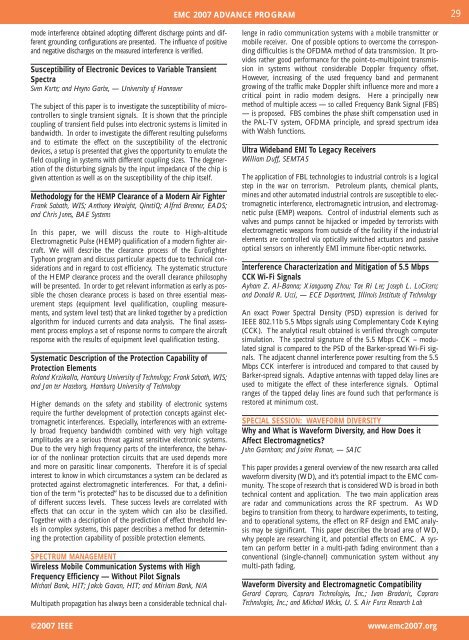2007 ieee international symposium on electromagnetic compatibility
2007 ieee international symposium on electromagnetic compatibility
2007 ieee international symposium on electromagnetic compatibility
You also want an ePaper? Increase the reach of your titles
YUMPU automatically turns print PDFs into web optimized ePapers that Google loves.
EMC <str<strong>on</strong>g>2007</str<strong>on</strong>g> ADVANCE PROGRAM29mode interference obtained adopting different discharge points and differentgrounding c<strong>on</strong>figurati<strong>on</strong>s are presented. The influence of positiveand negative discharges <strong>on</strong> the measured interference is verified.Susceptibility of Electr<strong>on</strong>ic Devices to Variable TransientSpectraSven Korte; and Heyno Garbe, — University of HannoverThe subject of this paper is to investigate the susceptibility of microc<strong>on</strong>trollersto single transient signals. It is shown that the principlecoupling of transient field pulses into electr<strong>on</strong>ic systems is limited inbandwidth. In order to investigate the different resulting pulseformsand to estimate the effect <strong>on</strong> the susceptibility of the electr<strong>on</strong>icdevices, a setup is presented that gives the opportunity to emulate thefield coupling in systems with different coupling sizes. The degenerati<strong>on</strong>of the disturbing signals by the input impedance of the chip isgiven attenti<strong>on</strong> as well as <strong>on</strong> the susceptibility of the chip itself.Methodology for the HEMP Clearance of a Modern Air FighterFrank Sabath, WIS; Anth<strong>on</strong>y Wraight, QinetiQ; Alfred Brenner, EADS;and Chris J<strong>on</strong>es, BAE SystemsIn this paper, we will discuss the route to High-altitudeElectromagnetic Pulse (HEMP) qualificati<strong>on</strong> of a modern fighter aircraft.We will describe the clearance process of the EurofighterTypho<strong>on</strong> program and discuss particular aspects due to technical c<strong>on</strong>siderati<strong>on</strong>sand in regard to cost efficiency. The systematic structureof the HEMP clearance process and the overall clearance philosophywill be presented. In order to get relevant informati<strong>on</strong> as early as possiblethe chosen clearance process is based <strong>on</strong> three essential measurementsteps (equipment level qualificati<strong>on</strong>, coupling measurements,and system level test) that are linked together by a predicti<strong>on</strong>algorithm for induced currents and data analysis. The final assessmentprocess employs a set of resp<strong>on</strong>se norms to compare the aircraftresp<strong>on</strong>se with the results of equipment level qualificati<strong>on</strong> testing.Systematic Descripti<strong>on</strong> of the Protecti<strong>on</strong> Capability ofProtecti<strong>on</strong> ElementsRoland Krzikalla, Hamburg University of Technology; Frank Sabath, WIS;and Jan ter Haseborg, Hamburg University of TechnologyHigher demands <strong>on</strong> the safety and stability of electr<strong>on</strong>ic systemsrequire the further development of protecti<strong>on</strong> c<strong>on</strong>cepts against <strong>electromagnetic</strong>interferences. Especially, interferences with an extremelybroad frequency bandwidth combined with very high voltageamplitudes are a serious threat against sensitive electr<strong>on</strong>ic systems.Due to the very high frequency parts of the interference, the behaviorof the n<strong>on</strong>linear protecti<strong>on</strong> circuits that are used depends moreand more <strong>on</strong> parasitic linear comp<strong>on</strong>ents. Therefore it is of specialinterest to know in which circumstances a system can be declared asprotected against <strong>electromagnetic</strong> interferences. For that, a definiti<strong>on</strong>of the term “is protected” has to be discussed due to a definiti<strong>on</strong>of different success levels. These success levels are correlated witheffects that can occur in the system which can also be classified.Together with a descripti<strong>on</strong> of the predicti<strong>on</strong> of effect threshold levelsin complex systems, this paper describes a method for determiningthe protecti<strong>on</strong> capability of possible protecti<strong>on</strong> elements.SPECTRUM MANAGEMENTWireless Mobile Communicati<strong>on</strong> Systems with HighFrequency Efficiency — Without Pilot SignalsMichael Bank, HIT; Jakob Gavan, HIT; and Miriam Bank, N/AMultipath propagati<strong>on</strong> has always been a c<strong>on</strong>siderable technical challengein radio communicati<strong>on</strong> systems with a mobile transmitter ormobile receiver. One of possible opti<strong>on</strong>s to overcome the corresp<strong>on</strong>dingdifficulties is the OFDMA method of data transmissi<strong>on</strong>. It providesrather good performance for the point-to-multipoint transmissi<strong>on</strong>in systems without c<strong>on</strong>siderable Doppler frequency offset.However, increasing of the used frequency band and permanentgrowing of the traffic make Doppler shift influence more and more acritical point in radio modem designs. Here a principally newmethod of multiple access — so called Frequency Bank Signal (FBS)— is proposed. FBS combines the phase shift compensati<strong>on</strong> used inthe PAL-TV system, OFDMA principle, and spread spectrum ideawith Walsh functi<strong>on</strong>s.Ultra Wideband EMI To Legacy ReceiversWilliam Duff, SEMTASThe applicati<strong>on</strong> of FBL technologies to industrial c<strong>on</strong>trols is a logicalstep in the war <strong>on</strong> terrorism. Petroleum plants, chemical plants,mines and other automated industrial c<strong>on</strong>trols are susceptible to <strong>electromagnetic</strong>interference, <strong>electromagnetic</strong> intrusi<strong>on</strong>, and <strong>electromagnetic</strong>pulse (EMP) weap<strong>on</strong>s. C<strong>on</strong>trol of industrial elements such asvalves and pumps cannot be hijacked or impeded by terrorists with<strong>electromagnetic</strong> weap<strong>on</strong>s from outside of the facility if the industrialelements are c<strong>on</strong>trolled via optically switched actuators and passiveoptical sensors <strong>on</strong> inherently EMI immune fiber-optic networks.Interference Characterizati<strong>on</strong> and Mitigati<strong>on</strong> of 5.5 MbpsCCK Wi-Fi SignalsAyham Z. Al-Banna; Xiaoguang Zhou; Tae Ri Lee; Joseph L. LoCicero;and D<strong>on</strong>ald R. Ucci, — ECE Department, Illinois Institute of TechnologyAn exact Power Spectral Density (PSD) expressi<strong>on</strong> is derived forIEEE 802.11b 5.5 Mbps signals using Complementary Code Keying(CCK). The analytical result obtained is verified through computersimulati<strong>on</strong>. The spectral signature of the 5.5 Mbps CCK – modulatedsignal is compared to the PSD of the Barker-spread Wi-Fi signals.The adjacent channel interference power resulting from the 5.5Mbps CCK interferer is introduced and compared to that caused byBarker-spread signals. Adaptive antennas with tapped delay lines areused to mitigate the effect of these interference signals. Optimalranges of the tapped delay lines are found such that performance isrestored at minimum cost.SPECIAL SESSION: WAVEFORM DIVERSITYWhy and What is Waveform Diversity, and How Does itAffect Electromagnetics?John Garnham; and Jaime Roman, — SAICThis paper provides a general overview of the new research area calledwaveform diversity (WD), and it’s potential impact to the EMC community.The scope of research that is c<strong>on</strong>sidered WD is broad in bothtechnical c<strong>on</strong>tent and applicati<strong>on</strong>. The two main applicati<strong>on</strong> areasare radar and communicati<strong>on</strong>s across the RF spectrum. As WDbegins to transiti<strong>on</strong> from theory, to hardware experiments, to testing,and to operati<strong>on</strong>al systems, the effect <strong>on</strong> RF design and EMC analysismay be significant. This paper describes the broad area of WD,why people are researching it, and potential effects <strong>on</strong> EMC. A systemcan perform better in a multi-path fading envir<strong>on</strong>ment than ac<strong>on</strong>venti<strong>on</strong>al (single-channel) communicati<strong>on</strong> system without anymulti-path fading.Waveform Diversity and Electromagnetic CompatibilityGerard Capraro, Capraro Technologies, Inc.; Ivan Bradaric, CapraroTechnologies, Inc.; and Michael Wicks, U. S. Air Force Research Lab©<str<strong>on</strong>g>2007</str<strong>on</strong>g> IEEE www.emc<str<strong>on</strong>g>2007</str<strong>on</strong>g>.org
















